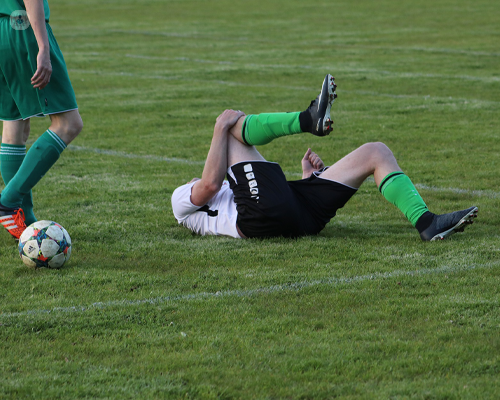Weak at the knees? How injuries can become chronic
Escrito por:Knee injuries are a common occurrence but no less frustrating, debilitating and sometimes life changing.
Mr Atik Malik, consultant trauma and orthopaedic surgeon, goes in-depth about this wide-reaching topic, providing expert advice about prevention, symptoms and how knee injuries can develop into chronic conditions such as arthritis.

How is the knee defined and how does it get injured?
The knee is classed as a ‘hinge’ joint and the largest in the human body. It consists of a complex of bones, ligaments, cartilage and tendons. The knee is involved in providing stability, forward propulsion and twisting of the lower leg and hence, is commonly injured in sporting activities, fitness work or as a result of direct trauma.
How can knee injuries be prevented?
The key to any injury is prevention and specific strategies should always include appropriate clothing/footwear, a warm up/warm down routine, avoiding sudden intensity changes and ensuring that your body mass index is under 25 (losing even 1lb, reduces the stress on your knees by 4lb!).
The importance of warm up is highlighted by program developed by FIFA which showed that teams completing the FIFA 11+ warm up program had 30 to 50 per cent less injured players! This program is very simple can be followed by anyone to help reduce injuries.
What is the most common knee injury?
The most common knee injury is a sprain/strain of the knee. This is associated with swelling and pain localised to the knee. The majority of these injuries settle within six weeks and are best treated with the RICE regimen, (Rest, Ice, Compression, Elevation). This can be supplemented with anti-inflammatory medication and simple pain killers (if safe to take).
If after the injury, you are unable to put weight on the leg, move the knee or have severe pain, this should prompt urgent specialist input. Following the initial 24 to 48 hours, it is always beneficial to keep moving the knee to prevent stiffness and muscle weakness.
What are the symptoms of knee injuries?
More severe knee injuries may lead to more worrying symptoms including clicking, locking (where the knee seizes up or needs gentle manipulation to get the knee moving again) and instability symptoms (often described as “I can’t rely on the knee” or “the knee gives way, often when changing directions or on stairs/inclines) should prompt specialist advice.
These symptoms are often seen when there is cartilage or ligament damage inside the knee and rarely settle without intervention. Particular sporting activities such as running, cycling and sports/ activities that involve jumping or kicking may lead to tendon inflammation with typically pain reported in the area of your knee just underneath your knee cap.
Apart from sporting/fitness activities, certain occupations often predispose individuals to knee conditions such as bursitis which is an inflammation of the fluid filled sacs in your knee. These sacs of fluid are designed to help cushioning in your knee and reduce friction. They are seen where kneeling/pressure on your knees may be a recurrent part of your day, such as in plumbers/floor layers.
Bursitis often responds well to conservative measures such as the RICE regimen in the short term with more long-term measures such as knee pads helping prevent future instances. Occasionally, these bursae may become inflamed due to external cuts/insect bites, leading to infection. When this occurs, you will require antibiotics and careful observation and is seen commonly in the summer months when we are spending more time outdoors.
How are knee injuries diagnosed?
Knee injuries are often diagnosed based on:
- The mechanism of injury;
- The symptoms being experienced;
- Findings on clinical examination and confirmed using plain x-rays and MRI scans.
Can knee injuries lead to arthritis?
I often see knee injuries in my practice that become chronic and lead to different forms of arthritis. The most common form of arthritis that you may be familiar with is the ‘wear and tear’ or degenerative arthritis, termed osteoarthritis. There are however, different forms of arthritis including:
- Inflammatory arthritis (rheumatoid arthritis being the most common form);
- Crystal deposition arthritis (where different crystals are deposited inside your knee joint causing irritation; gout being the most commonly known) and;
- Infective arthritis (this is where bugs get inside your knee joint causing inflammation and damage requiring urgent treatment).
Often knee injuries such as fractures may cause damage to the cartilage inside the knee leading later in life to post-traumatic arthritis.
What all of these types of arthritis have in common however, is that eventually, they may lead to damage inside the knee which may be irreversible. Early specialist input may help in preventing/ slowing further damage whilst controlling symptoms of pain, swelling, grating, inflammation and stiffness.
Whilst my own philosophy is that “the best knee in your body is your own” and often try all available measures that modern healthcare technology offers including rehabilitation, physiotherapy, use of braces/orthotics, and the use of (patient-tailored) injection therapy, when irreversible damage has occurred and conservative measures have failed, surgery may be the only viable option.
This may include minimally-invasive approaches using key-hole surgery to repair/reconstruct and use the principles of tissue engineering. This allows patients to return to their functional activities whilst maintaining their own native knee joints and avoiding major surgery. However, when the damage to the knee joint is more severe and these approaches are unlikely to help, it can be more prudent to think about more traditional approaches, such as knee replacement.
Knee replacement, in the modern era, may now involve either partial or total knee replacement with partial knee replacements offering patients a smaller incision, less post-operative pain and earlier return to function. Even patients undergoing total knee replacement often comment on how the procedure was the best thing they have ever done and tell me “I wish I had done it sooner!” The days of spending two weeks in hospital are long gone with a typical hospital stay following knee replacement being one to two days.
If you’d like top medical attention for any knee injuries you may have, arrange a consultation with Mr Malik via his Top Doctors profile.


